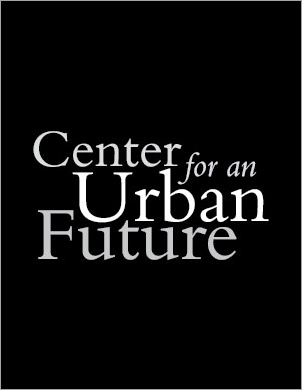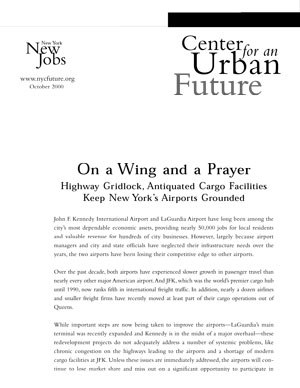Good afternoon. Thank you for inviting me to testify today. My name is Jonathan Bowles and I am the research director of the Center for an Urban Future, an independent and non-partisan policy think tank that issues studies on economic development and job creation strategies in New York City.
I would like to congratulate Chairman Sanders and the members of this committee for having a hearing about an industry that gets little attention but packs a powerful punch for New York City’s economy. Three years ago, I authored a report (titled “On a Wing and a Prayer”) about the economic impact of New York City’s air cargo industry and the many significant obstacles facing this important sector. In November 2002, I published another report (titled “Bumpy Skies”) that talked about the disproportionate impact that 9/11 was having on passenger traffic levels and cargo movements at New York’s airports.
There are a number of reasons why I believe the air cargo industry deserves more attention from the city’s economic development officials. First, the industry provides thousands of jobs in Queens—-in our 2000 report, we revealed that the cargo industry accounts for 44 percent of all employment at Kennedy and 45 percent of total wages earned at the airport. It’s also a critical part of Queens’ economy, with a large multiplier effect on other businesses in the borough. But, there are other more compelling reasons:
1) Air cargo movements in the U.S. and internationally are expected to grow at an astonishingly high clip over the next decade. According to the FAA’s 2003 Aerospace Forecasts, air cargo movements in and out of U.S. airports are expected to increase by 5 percent a year between now and 2014. International cargo, which happens to be JFK’s strongpoint, is expected to outpace domestic freight grow—increasing by 5.8 percent a year.
At the moment, there aren’t many fast-growing industries that are already firmly rooted in New York. Air cargo is one. In fact, it’s an industry for which New York City has a competitive advantage—-due to JFK’s longtime status as a worldwide center for air cargo and the airport’s cadre of experienced freight forwarders, custom house brokers, federal customs agents and other industry professionals.
2) It’s becoming increasingly clear that New York City desperately needs to diversify its economy and, more importantly, needs to identify new sources of employment growth in the decades ahead. Wall Street just isn’t go to be enough anymore. By itself, the air cargo industry isn’t going to rescue the city’s economy. But with proper support from the city and state, this industry could contribute to the city’s future job growth and help diversify the local economy.
3) The city not only needs to find new sources of employment growth, it needs to do a much better job retaining and producing jobs that employ new immigrants and others who don’t have the skills to get jobs on Wall Street or in high-tech sectors. In the past few decades, the city has failed miserably on this score. Simply put, the city’s economy—-during both booms and busts-—is not producing enough jobs for a significant portion of its population. To give an indication of this, only once since 1970 has the city’s unemployment rate dropped below 6 percent—while the national unemployment rate has finished a year below that mark 16 times during the same period, including 11 of the past 15 years.
Obviously, the air cargo sector offers a lot of potential for New York’s economy—-not only as a source of overall employment growth, but also a source of blue collar jobs. But the industry here faces significant barriers to growth—and it is by no means assured that New York City will participate in the future growth expected for the industry.
While Kennedy remains the fifth busiest cargo airport in the U.S., it was No. 1 in the world until 1990. JFK will probably always be a major cargo destination, but it’s no longer assured that Kennedy will automatically capture a proportional share of the industry’s growth. Because of technological advances, smaller aircraft can fly longer distances, and cities that would have trouble filling up seats on large 747s now offer regular overseas flights. To a large degree, cargo can just as easily be shipped into airports in Miami, Chicago, Atlanta or Newark.
And, that’s exactly what’s been happening. Between 1991 and 2002, cargo traffic increased by 79 percent at Newark International Airport; by 68 percent at Miami International Airport; by 56 percent at Los Angeles International Airport; and by 49 percent at Chicago O’Hare Airport. During the same period, cargo traffic at JFK grew only by 26 percent.
Moreover, while much of the growth in the air cargo sector has occurred among overnight carriers-—like Fedex, UPS, Airborne and DHL—-most of these businesses have greatly reduced their presence at JFK over the past 10 to 15 years. Fedex and UPS transported a combined total of 661,000 tons of freight to Newark during the year ending in September 2003, but less than 200,000 tons to JFK. Those businesses rely on speed—-getting parcels from the plane to their destination, usually in Manhattan’s central business districts. And even though JFK is actually fewer miles from Midtown Manhattan than Newark Airport, mounting delays on the Van Wyck Expressway and the absence of alternative routes into Manhattan has caused overnight freight firms to opt for the convenience of Newark.
The main challenge facing the industry-—by a long shot-—is road access to Kennedy Airport. There is only one highway route that leads from JFK to Manhattan and the highways outside of the city—the Van Wyck Expressway—and that route is plagued by chronic congestion. Trucks picking up cargo at the airport often sit for hours on the Van Wyck Expressway on their way out of the city.
In this age of just-in-time distribution, New York City is not competing. We’re inefficient. And unless this changes sometime soon, we’re going to lose our competitive advantage in this industry.
There has been some progress. The development of the AirTrain, for example, is a huge accomplishment, and when it opens it should help get cars off the Van Wyck. I commend the Port Authority for making this happen, but I hope that the AirTrain eventually can become a one-seat ride from Midtown to the airport.
There are other workable solutions that, if implemented, could go a long way to helping ensure the future growth of this sector in New York. Among them:
1) Open the Belt Parkway to commercial vans. Currently, the Belt Parkway prohibits all commercial vehicles, from 53-foot trucks to the commercial vans often used by overnight delivery companies. The Belt would provide a much faster alternative route for companies delivering goods to offices in lower Manhattan, and could possibly enable Kennedy to recapture some of the lost overnight freight companies that shifted to Newark Airport over the past decade. Doing this would not open the door for trucks to operate on the parkway, since the low height of bridges over the Belt simply does not make it possible for trucks to be there.
2) Close one or two entrance ramps on the Van Wyck Expressway during certain peak hours. Doing so would help put an end to the common practice, mostly by taxis, of using the service road to get off and on the Van Wyck—-a ritual that slows down traffic on the highway. Doing this would help make the Van Wyck more of an “expressway”.
3) Implement variable message signage on the Van Wyck. For a relatively small cost, the city could use high-tech signage to provide real-time traffic instructions to motorists and help speed the flow of traffic on the expressway. Several other cities have used high-tech signage to greatly reduce traffic congestion during peak times.
4) Create a fourth lane on the Van Wyck. City and State transportation officials should seriously look into the possibility of using the excess shoulder space added to the Van Wyck during construction of AirTrain to create a fourth lane.




